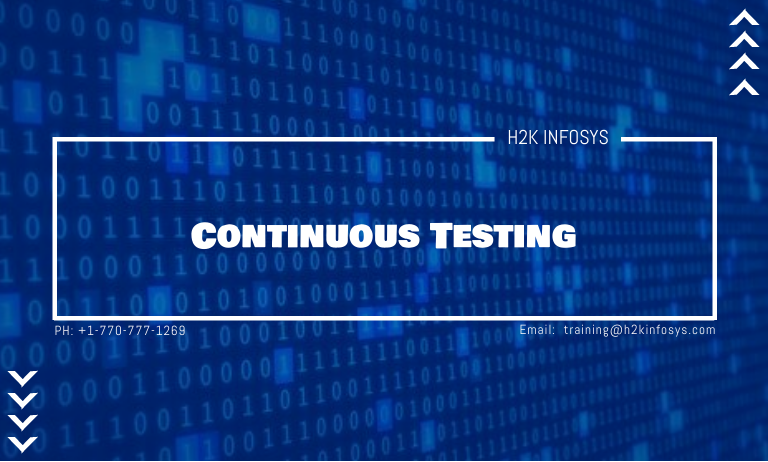In today’s fast-paced digital landscape, where applications are deployed multiple times a day, traditional testing methods are no longer enough. Businesses demand faster releases without compromising quality. Continuous Testing bridges this gap, ensuring software reliability, functionality, and security at every stage of development.
Whether you’re pursuing a Quality assurance tester course understanding Continuous Testing is essential to mastering modern software delivery pipelines.

What Is Continuous Testing?
This process of executing automated tests as part of the software delivery pipeline to obtain immediate feedback on business risks associated with a software release.
Instead of waiting until the end of the development cycle, Continuous Testing integrates testing into every stage from code commit to production deployment. This helps detect and fix defects early, improving product quality and reducing time to market.
Key Principles of Continuous Testing:
- Automation at Every Stage: Tests are triggered automatically with every build or code change.
- Shift-Left Approach: Testing starts early in the development process.
- Immediate Feedback: Teams receive real-time insights about the impact of code changes.
- Risk-Based Testing: Focus on areas that pose the highest business risks.
- Integration with DevOps: Continuous Testing works hand-in-hand with Continuous Integration (CI) and Continuous Deployment (CD).
Why Continuous Testing Matters in Software Development
Modern applications are complex, involving multiple integrations, microservices, and third-party APIs. With fast delivery cycles, manual testing can’t keep up. Continuous Testing ensures that every update or modification passes through automated validation before it reaches users.
Major Benefits:
- Early Detection of Bugs: Errors are identified at the coding stage, reducing rework.
- Faster Releases: Automated tests allow continuous delivery pipelines to move at speed.
- Improved Quality Assurance: Consistent testing ensures a higher standard of product reliability.
- Cost Efficiency: Early bug detection lowers the cost of fixing defects later in the cycle.
- Better Collaboration: Developers, testers, and operations teams work in sync under the DevOps model.
Students enrolled in a software testing course will learn how Continuous Testing supports agile development by embedding quality checks within each build cycle.
How Continuous Testing Fits into DevOps and CI/CD
It is a cornerstone of DevOps and CI/CD pipelines. In a typical DevOps workflow:
- Code Integration (CI): Developers commit code frequently. Automated builds and unit tests validate the integration.
- Continuous Testing: Automated functional, regression, and performance tests are triggered after each build.
- Continuous Deployment (CD): Once validated, the build moves automatically to staging or production.
This integrated approach ensures that any issue detected at one stage prevents further propagation down the pipeline, saving time and resources.

The Continuous Testing Lifecycle
Let’s break down the Continuous Testing process step by step:
1. Planning and Test Design
Teams define test cases, determine automation scope, and prioritize critical business workflows.
- Identify reusable test scripts.
- Select tools and frameworks suitable for the project (e.g., Selenium, JUnit, TestNG).
2. Test Environment Setup
Virtualized or containerized environments are created for consistency. Tools like Docker and Kubernetes ensure scalability and parity between environments.
3. Automation and Execution
Automated tests—unit, integration, API, UI, and security—are executed as part of every build.
For example, a Quality assurance tester course will train students to automate these tests using real-world tools.
4. Feedback and Reporting
Test results are integrated into dashboards such as Jenkins, Azure DevOps, or GitLab CI, providing immediate visibility into the quality of each build.
5. Defect Management and Retesting
Issues are logged automatically in tools like JIRA or Bugzilla and assigned for quick resolution.
6. Continuous Monitoring
Monitoring continues post-deployment to identify performance bottlenecks or production issues.
Key Tools Used in Continuous Testing
Automation tools are the foundation of Continuous Testing. Let’s explore some widely used ones:
1. Selenium
An open-source framework for automating web applications across browsers. A software testing course will typically include hands-on Selenium training for UI testing.
2. Jenkins
A CI/CD server that triggers automated builds and tests whenever changes are pushed to the codebase.
3. JUnit and TestNG
Popular frameworks for unit testing Java applications. They enable quick verification of individual components.
4. Postman and REST Assured
Used for API testing, ensuring back-end services perform as expected.
5. Cucumber
Supports Behavior-Driven Development (BDD), allowing tests to be written in plain English for better collaboration.
6. Docker and Kubernetes
Help maintain consistent testing environments through containerization and orchestration.
7. SonarQube
Analyzes code quality and provides insights into vulnerabilities, code smells, and maintainability.
Continuous Testing vs Traditional Testing
| Aspect | Traditional Testing | Continuous Testing |
|---|---|---|
| Timing | After development phase | Integrated throughout development |
| Speed | Slower, often manual | Fast, automated |
| Feedback | Late, after full build | Immediate, continuous |
| Tooling | Minimal automation | Fully automated pipeline |
| Risk Detection | Late in SDLC | Early in SDLC |
| Integration | Isolated testing | Integrated with DevOps and CI/CD |
This comparison highlights why Continuous Testing is the preferred choice in modern agile and DevOps-driven environments.
The Role of Automation in Continuous Testing
Automation is the heart of Continuous Testing. By scripting repetitive test cases and integrating them into the build pipeline, teams can achieve:
- Consistency: The same tests run reliably across environments.
- Coverage: Automation increases test coverage across functionalities.
- Scalability: Large applications with thousands of test cases can be validated quickly.
- Speed: Builds and deployments are validated in minutes, not days.
For anyone enrolled in a Quality assurance tester course, mastering test automation frameworks like Selenium, Cypress, or Playwright is critical to excelling in Continuous Testing roles.
Types of Tests in Continuous Testing
Continuous Testing involves a combination of various testing types, executed automatically and frequently:
- Unit Testing: Validates individual components or modules.
- Integration Testing: Ensures multiple modules work together seamlessly.
- Functional Testing: Validates business requirements.
- Regression Testing: Detects if new code changes affect existing functionality.
- Performance Testing: Measures speed, responsiveness, and stability.
- Security Testing: Identifies vulnerabilities and threats.
- User Interface Testing: Verifies design and layout accuracy.
This layered testing approach ensures complete coverage and continuous quality validation.
Challenges in Continuous Testing
Despite its benefits, Continuous Testing comes with challenges that organizations must address:
1. Tool Integration Complexity
Different tools must work together seamlessly—test management, CI/CD, monitoring, and reporting.
2. High Maintenance of Test Scripts
Frequent application changes require regular test script updates.
3. Environment Stability
Inconsistent test environments can lead to unreliable test results.
4. Cultural Shift
Organizations must embrace DevOps culture—breaking silos between development, testing, and operations.
5. Test Data Management
Maintaining realistic and secure test data across stages is essential for accuracy.
Enrolling in a software testing course helps testers learn strategies to overcome these challenges, including environment setup, test orchestration, and data handling.
Best Practices for Effective Continuous Testing
- Shift Left: Start testing early to catch defects sooner.
- Automate Everything: Focus on repetitive and critical test scenarios.
- Use Version Control: Maintain test scripts alongside application code (Git, Bitbucket).
- Maintain Fast Feedback Loops: Integrate test results into developer workflows.
- Prioritize Tests: Execute high-impact tests first during every build.
- Leverage Cloud Environments: Use scalable infrastructure for faster test execution.
- Monitor Metrics: Track test pass rates, defect density, and mean time to repair (MTTR).
These practices ensure Continuous Testing delivers on its promise of faster, safer, and higher-quality software releases.
Real-World Example: Continuous Testing in Action
Let’s consider an e-commerce application:
- Developers commit a new feature for “Add to Cart.”
- Jenkins triggers the build automatically.
- Automated unit tests check basic functionality.
- Integration tests validate connections with the payment gateway.
- Regression tests ensure existing features (like checkout or wishlist) are unaffected.
- Upon success, the build is deployed automatically to staging.
- Monitoring tools ensure stable performance under load.
This continuous feedback loop accelerates delivery while maintaining user trust and application stability.
Future of Continuous Testing
The future of Continuous Testing is evolving with AI and Machine Learning (ML) integration. Intelligent testing systems can now:
- Predict which test cases are likely to fail based on code changes.
- Optimize test coverage dynamically.
- Self-heal broken automation scripts.
- Identify flaky tests and eliminate false positives.
AI-driven analytics will make Continuous Testing smarter, faster, and more efficient reshaping how QA professionals work.
If you’re planning to build a career Software testing course that includes Continuous Testing and AI-based automation is your gateway to becoming an industry-ready testing expert.
Key Takeaways
- Continuous Testing ensures software quality through automation across all development stages.
- It integrates deeply with DevOps and CI/CD pipelines for faster, reliable releases.
- Tools like Selenium, Jenkins, Docker, and SonarQube play crucial roles.
- Test automation, environment consistency, and real-time feedback are key pillars.
- Continuous Testing isn’t just a technique—it’s a cultural shift toward collaboration and speed.
Conclusion
Continuous Testing has redefined how quality assurance is practiced in modern software development. Instead of acting as a final checkpoint, testing now flows continuously providing instant validation of every code change.
By mastering Continuous Testing through a Quality assurance tester course or software testing course, aspiring professionals can align themselves with the future of DevOps and agile delivery. The demand for QA experts who understand automated pipelines, CI/CD, and risk-based testing continues to grow, offering immense career opportunities in 2025 and beyond.
























8 Responses
Continuous testing is series of incorporating automated feedback at different stages of the software development life cycle which supports better speed and efficiency when managing deployments. Continuous testing may be driver behind the effectiveness of CI/CD (continuous integration/continuous delivery) processes and plays an important role in accelerating SDLC timeliness by improving code quality, avoiding costly bottlenecks and expediting DeVos processes.
The main key point of continuous testing is
The primary aim of continuous testing is assessing the business risk coverage.
This testing provides instant insight on whether a release candidate is just too risky to proceed through the delivery pipeline.
This testing establishes a security net that helps team protect the user experience in accelerated development processes and avoid software failure headlines.
Continuous testing is integrated into software delivery pipeline and also Devops tool chain.
Continuous testing expects a stable test environment with valid test data be available for every and each test run.
Continuous testing is continuously reviewing and optimising the test suite to eliminate redundancy and maximise business risk coverage.
Continuous testing involves series of execution of the proper set of tests at the proper stage of delivery pipeline without creating a bottleneck.
Continuous tests include end-end tests which must be broad enough to detect, when the appliance changes inadvertently which impacts functionality where users have come to depend upon.
Advantages:
Better efficiency and better quality deployments
The continuous testing proceeds an automatic method of handling the standard quality assurance and also quality interoperation between workflows at every stage of the software development life cycle. By integrating constant feedback loops into the user modules and also unit testing modules. This efficiency will solve the disconnections between multiple Devops team members and also supports accelerated software delivery schedules.
Rapid error discovery and remediation for distributed projects
This modern development team’s break down these complexities by indulging a scalable, automated testing solution. That’s importantly improves error discovery and remediation timeliness.
Improved User experience
In the advanced sort of continuous testing methods can stimulate a spread of unique use cases and troubleshooting scenarios and observe how users responds to them.
Elimination of business disruption and its costs
Cloud providers consider an example daily report breakdown at one end which paralyse a whole region and cause outrages lasting for several hours. This is a particularly devastating to organisations which are dependent on high service availability.
Continuous testing (CT) is a software development process in which applications are tested continuously throughout the entire software development life cycle (SDLC). The goal of CT is to evaluate software quality across the SDLC, providing critical feedback earlier and enabling higher-quality and faster deliveries.
The main key point of continuous testing is:
*The primary aim of continuous testing is assessing the business risk coverage.
*This testing provides instant insight on whether a release candidate is just too risky to proceed through the delivery pipeline.
*This testing establishes a security net that helps team protect the user experience in accelerated development processes and avoid software failure headlines.
*Continuous testing is integrated into software delivery pipeline and also Devops tool chain.
*Continuous testing expects a stable test environment with valid test data be available for every and each test run.
*Continuous testing is continuously reviewing and optimising the test suite to eliminate redundancy and maximise business risk coverage.
*Continuous testing involves series of execution of the proper set of tests at the proper stage of delivery pipeline without creating a bottleneck.
*Continuous tests include end-end tests which must be broad enough to detect, when the appliance changes inadvertently which impacts functionality where users have come to depend upon.
Benefits of Continuous testing:
The following are the advantages:
1.Better efficiency and better quality deployments
2.Rapid error discovery and remediation for distributed projects
3Improved User experience
4.Elimination of business disruption and its costs
Continuous testing is a series of incorporating automated feedback at different stages of the software development life cycle which supports better speed and efficiency when managing deployments. Continuous testing may be the driver behind the effectiveness of CI/CD (continuous integration/continuous delivery) processes and plays an important role in accelerating SDLC timeliness by improving code quality, and avoiding costly bottlenecks.
The key points of continuous testing are:
Assessing the business risk coverage.
Provides instant insight on whether a release candidate is just too risky to proceed through the delivery pipeline.
Establishes a security net that helps the team protect the user experience in accelerated development processes and avoid software failure headlines.
Is integrated into the software delivery pipeline and also DevOps toolchain.
Expects a stable test environment with valid test data to be available for each and every test run.
Continuous testing is continuously reviewing and optimizing the test suite to eliminate redundancy and maximize business risk coverage.
The following are the advantages of Continuous testing:
Better efficiency and better quality deployments
Rapid error discovery and remediation for distributed projects
Improved User experience
Elimination of business disruption and its costs
Continuous testing is series of incorporating automated feedback at different stages of the software development life cycle which supports better speed and efficiency when managing deployments. Continuous testing may be driver behind the effectiveness of CI/CD (continuous integration/continuous delivery) processes and plays an important role in accelerating SDLC timeliness by improving code quality, avoiding costly bottlenecks and expediting Devops processes.
The main key points continuous testing is
– The primary aim of continuous testing is assessing the business risk coverage.
-This testing provides instant insight on whether a release candidate is just too risky to proceed through the delivery pipeline.
-This testing establishes a security net that helps team protect the user experience in accelerated development processes and avoid software failure headlines.
Continuous testing is integrated into software delivery pipeline and also Devops tool chain.
Continuous testing expects a stable test environment with valid test data be available for every and each test run.
Continuous testing is continuously reviewing and optimising the test suite to eliminate redundancy and maximise business risk coverage.
-Continuous testing involves series of execution of the proper set of tests at the proper stage of delivery pipeline without creating a bottleneck.
-Continuous tests include end-end tests which must be broad enough to detect, when the appliance changes inadvertently which impacts functionality where users have come to depend upon.
Continuous testing is series of incorporating automated feedback at different stages of the software development life cycle which supports better speed and efficiency when managing deployments. Continuous testing may be driver behind the effectiveness of CI/CD (continuous integration/continuous delivery) processes and plays an important role in accelerating SDLC timeliness by improving code quality, avoiding costly bottlenecks.
The key points of continuous testing is:
Assessing the business risk coverage.
Provides instant insight on whether a release candidate is just too risky to proceed through the delivery pipeline.
Establishes a security net that helps team protect the user experience in accelerated development processes and avoid software failure headlines.
Is integrated into software delivery pipeline and also Devops tool chain.
Expects a stable test environment with valid test data be available for each and every test run.
Continuous testing is continuously reviewing and optimising the test suite to eliminate redundancy and maximise business risk coverage.
The following are the advantages of Continuous testing:
Better efficiency and better quality deployments
Rapid error discovery and remediation for distributed projects
Improved User experience
Elimination of business disruption and its costs
Continuous testing
Continuous testing is a series of incorporating automated feedbacks at different stages of SDLC which supports better efficiency and speed when managing deployments. It plays an important role in accelerating timeliness of SDLC by improving code quality ,costly bottlenecks and expediting development processes.
Key points of continuous testing:
1. It accesses business risk coverage
2. It provides instant insight on whether a candidate release is too risky to proceed through delivery pipeline.
3. It establishes security net to help team to avoid software failure.
4. It expects stable environment with valid data in each and every test run.
5. It involves series of execution with the set of data at the proper stage to avoid creating bottlenecks.
6. It tests user friendly feature of application.
Benefits of Continuous testing:
1. Better efficiency and better deployments
2. Rapid error discovery
3. Improved user experience
4. Elimination of business rules and its cost.
Continuous testing is series of incorporating automated feedback at different stages of the software development life cycle which supports better speed and efficiency when managing deployments. It may be driver behind the effectiveness of CI/CD (continuous integration/continuous delivery) processes and plays an important role in accelerating SDLC timelines by improving code quality, avoiding costly bottlenecks and expediting Devops processes.
Main key points of continuous testing is
– The primary aim of continuous testing is assessing the business risk coverage.
– This testing provides instant insight on whether a release candidate is just too risky to proceed through the delivery pipeline.
– This testing establishes a security net that helps team protect the user experience in accelerated development processes and avoid software failure headlines.
– Continuous testing is integrated into software delivery pipeline and also Devops tool chain.
– Continuous testing expects a stable test environment with valid test data be available for every and each test run.
– Continuous testing is continuously reviewing and optimizing the test suite to eliminate redundancy and maximize business risk coverage.
– Continuous testing involves series of execution of the proper set of tests at the proper stage of delivery pipeline without creating a bottleneck.
– Continuous tests include end-end tests which must be broad enough to detect, when the appliance changes inadvertently which impacts functionality where users have come to depend upon.
Benefits of continuous testing are: better efficiency and better quality deployments, rapid error discovery and remediation for distributed projects, improved user experience, and elimination of business disruption and its costs.
Continuous testing is series of incorporating automated feedback at different stages of the software development life cycle which supports better speed and efficiency when managing deployments. Continuous testing may be driver behind the effectiveness of CI/CD (continuous integration/continuous delivery) processes and plays an important role in accelerating SDLC timeliness by improving code quality, avoiding costly bottlenecks and expediting Devops processes.
The main key point of continuous testing is
The primary aim of continuous testing is assessing the business risk coverage.
This testing provides instant insight on whether a release candidate is just too risky to proceed through the delivery pipeline.
This testing establishes a security net that helps team protect the user experience in accelerated development processes and avoid software failure headlines.
Continuous testing is integrated into software delivery pipeline and also Devops tool chain.
Continuous testing expects a stable test environment with valid test data be available for every and each test run.
Continuous testing is continuously reviewing and optimising the test suite to eliminate redundancy and maximise business risk coverage.
Continuous testing involves series of execution of the proper set of tests at the proper stage of delivery pipeline without creating a bottleneck.
Continuous tests include end-end tests which must be broad enough to detect, when the appliance changes inadvertently which impacts functionality where users have come to depend upon.